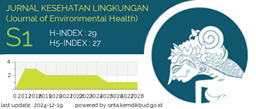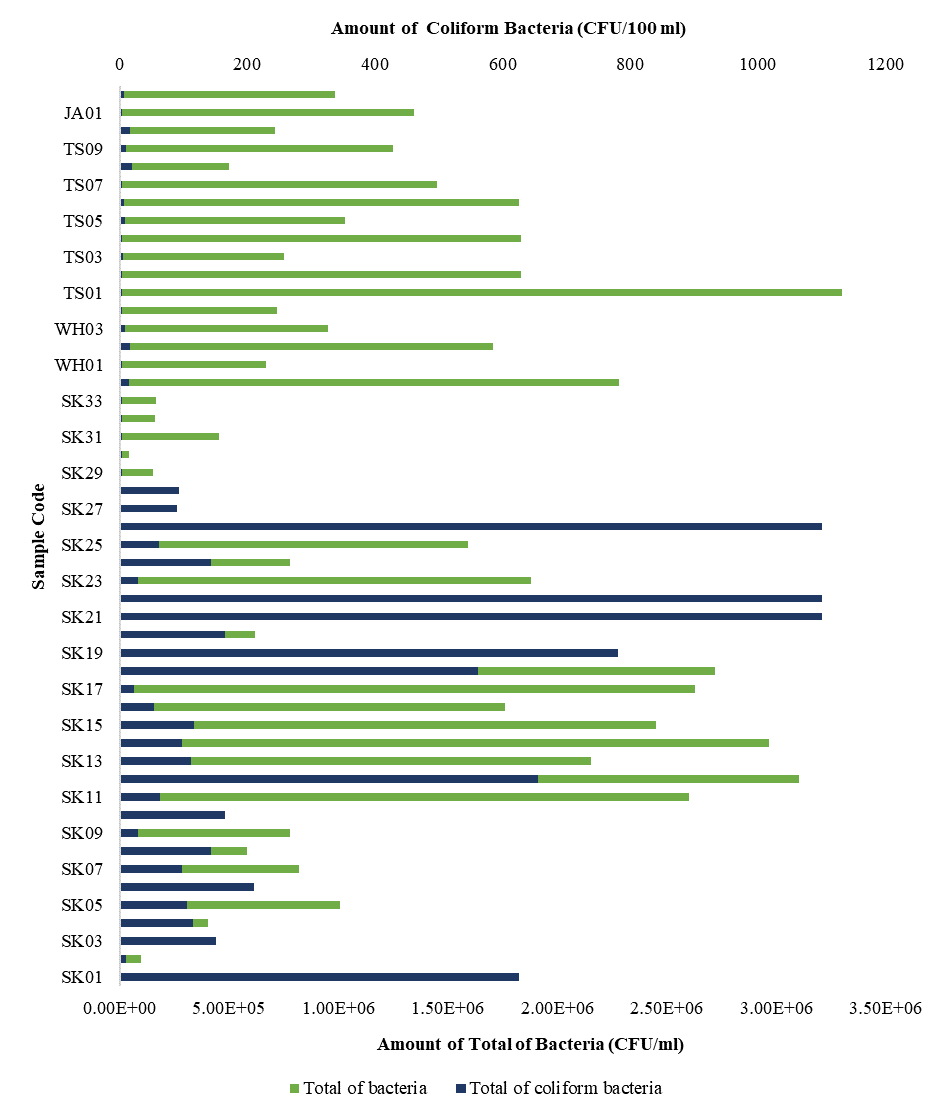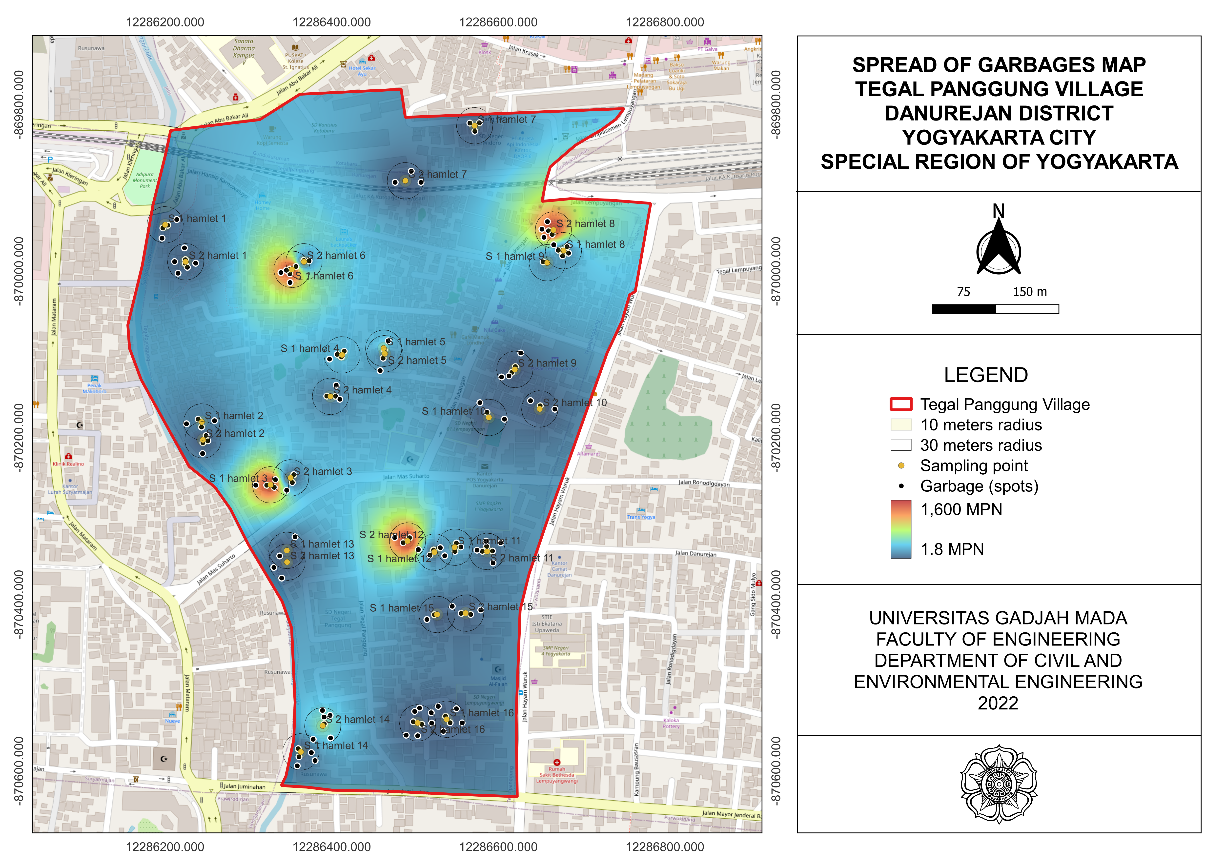Determinants of Persistent Organic Pollutants (POPs) Levels in Human Specimens: A Review
Downloads
Introduction: Numerous studies have been conducted regarding persistent organic pollutants (POPs) concentrations in human biological matrices such as blood, breast milk, urine, and hair that cause adverse health effects such as breast cancer, cardiovascular diseases, and type 2 diabetes. This study aimed to determine the POPs presence in human specimens in household settings. Discussion: A total of 28 articles were included in this study with the criteria published in 2016- 2021, original research articles, free full text available, and studied at least one of the confounding variables of POPs levels in human specimens. The narrative method was selected to synthesize this study. Grouping articles with similar results was carried out to respond to research questions. This study discovered that age, dietary habits, BMI, sex, race/ethnicity, smoking status, physical activities, residency, household dust, and industry emissions were associated with POPs levels in human specimens. Conclusion: This study concluded that each determinant could not affect the POPs levels in the human specimens on its own since those determinants are influenced by each other. Future research using systematic literature review and meta-analysis is therefore strongly advised.
Tiwari M, Sahu SK, Pandit GG. Distribution and Ecotoxicological Concerns of Persistent Organic Pollutants in Sediment from Creek Ecosystem. Journal of Environmental Science and Health, Part B. 2016;51(9):616–621. https://doi.org/10.1080/03601234.2016.1181907
Nežiková B, Degrendele C, ÄŒupr P, Hohenblum P, Moche W, ProkeÅ¡ R, et al. Bulk Atmospheric Deposition of Persistent Organic Pollutants and Polycyclic Aromatic Hydrocarbons in Central Europe. Environmental Science and Pollution Research. 2019;26(23):23429–23441. https://doi.org/10.1007/s11356-019-05464-9
Choo G, Wang W, Cho HS, Kim K, Park K, Oh JE. Legacy and Emerging Persistent Organic Pollutants in the Freshwater System: Relative Distribution, Contamination Trends, and Bioaccumulation. Environment International. 2020;135(105377):1-8. https://doi.org/10.1016/j.envint.2019.105377
Ashraf MA. Persistent Organic Pollutants (POPs): A Global Issue, A Global Challenge. Environmental Science and Pollution Research. 2017;24(5):4223–4227. https://doi.org/10.1007/s11356-015-5225-9
Agency for Toxic Substances and Disease Registry. Toxicological for DDT/DDE/DDD (Update). Atlanta, GA: U.S. Department of Health and Human Services, Public Health Service. 2002. http://www.atsdr.cdc.gov/toxfaqs/index.asp
Al Antary TM, Alawi MA, Estityah H, Haddad N. Organochlorine Pesticides Residues in Human Breast Milk from the Middle Governorates in Jordan in 2013/2014. Bulletin of Environmental Contamination and Toxicology. 2017;99(1):89–92. https://doi.org/10.1007/s00128-017-2117-3
Islam R, Kumar S, Karmoker J, Kamruzzaman M, Rahman MA, Biswas N, et al. Bioaccumulation and Adverse Effects of Persistent Organic Pollutants (POPs) On Ecosystems and Human Exposure: A Review Study on Bangladesh Perspectives. Environmental Technology & Innovation. 2018;12(1):115–131. https://doi.org/10.1016/j.eti.2018.08.002
Fry K, Power MC. Persistent Organic Pollutants and Mortality in the United States, NHANES 1999–2011. Environmental Health. 2017;16(105):1-12. https://doi.org/10.1186/s12940-017-0313-6
Aerts R, Van Overmeire I, Colles A, Andjelković M, Malarvannan G, Poma G, et al. Determinants of Persistent Organic Pollutant (POP) Concentrations in Human Breast Milk of a Cross-Sectional Sample of Primiparous Mothers in Belgium. Environment International. 2019;131(104979):1-10. https://doi.org/10.1016/j.envint.2019.104979
Waheed S, Khan MU, Sweetman AJ, Jones KC, Moon HB, Malik RN. Exposure of Polychlorinated Naphthalenes (PCNs) To Pakistani Populations via Non-Dietary Sources From Neglected E-Waste Hubs: A Problem of High Health Concern. Environmental Pollution. 2020;259:113838. https://doi.org/10.1016/j.envpol.2019.113838
Mansouri EH, Reggabi M. Plasma Concentrations of Chlorinated Persistent Organic Pollutants and Their Predictors in the General Population of Algiers, Algeria. Emerging Contaminants. 2021;7:35–42. https://doi.org/10.1016/j.emcon.2020.12.003
Trejo-Acevedo A, Rivero-Pérez NE, Flores-Ramírez R, Sandra, Orta-García T, José, et al. Assessment of the Levels of Persistent Organic Pollutants and 1-Hydroxypyrene in Blood and Urine Samples from Mexican Children Living in an Endemic Malaria Area in Mexico. Bulletin of Environmental Contamination and Toxicology. 2012;88(6):828–832. https://doi.org/10.1007/s00128-012-0593-z
Junqué E, Garí M, Arce A, Torrent M, Sunyer J, Grimalt JO. Integrated Assessment of Infant Exposure to Persistent Organic Pollutants and Mercury via Dietary Intake in a Central Western Mediterranean Site (Menorca Island). Environmental Research. 2017;156(1):714–24. https://10.0.3.248/j.envres.2017.04.030
Chen MW, Santos HM, Que DE, Gou YY, Tayo LL, Hsu YC, et al. Association Between Organochlorine Pesticide Levels in Breast Milk and Their Effects on Female Reproduction in a Taiwanese Population. International Journal of Environmental Research and Public Health. 2018;15(5):1-22. https://doi.org/10.3390/ijerph15050931
United Nations Environment Programme. Listing of POPs in the Stockholm Convention. Switzerland: United Nations Environment Programme. 2021. http://chm.pops.int/TheConvention/ThePOPs/ListingofPOPs/tabid/2509/Default.aspx
United Nations Environment Programme. Stockholm Convention Protecting Human Health and Environment from Persistent Organic Pollutants. Switzerland: United Nations Environment Programme. 2019. http://www.pops.int
World Health Organization. Global Insecticide Use for Vector-Borne Disease Control: A 10-year Assessment (2000-2009). 5th ed. Geneva: World Health Organization Press; 2011.
Jiang X, Liu G, Wang M, Zheng M. Formation of Polychlorinated Biphenyls on Secondary Copper Production Fly Ash: Mechanistic Aspects and Correlation to Other Persistent Organic Pollutants. Scientific Reports. 2015;5(1):1–10. https://doi.org/10.1038/srep13903
United Nations Environment Programme. Guidance for The Inventory of Polybrominated Diphenyls (PBDEs) Listed Under the Stockholm Convention on Persistent Organic Pollutants. 2012. Switzerland: United Nations Environment Programme. 1–129 p. http://sib3pop.menlhk.go.id/uploads/Regulasi/UNEP-POPS-GUID-NIP-2012-PBDEs-Inventory.En.pdf
Environmental Protection Agency. Persistent Organic Pollutants: A Global Issue, A Global Response | US EPA. United States: Environmental Protection Agency; 2009. https://www.epa.gov/international-cooperation/persistent-organic-pollutants-global-issue-global-response#affect
Rahman ML, Zhang C, Smarr MM, Lee S, Honda M, Kannan K, et al. Persistent Organic Pollutants and Gestational Diabetes: A Multi-Center Prospective Cohort Study of Healthy US Women. Environment International. 2019;124(1):249–258. https://doi.org/10.1016/j.envint.2019.01.027
Wolf K, Bongaerts BWC, Schneider A, Huth C, Meisinger C, Peters A, et al. Persistent Organic Pollutants and the Incidence of Type 2 Diabetes in the CARLA and KORA Cohort Studies. Environment International. 2019;129(1):221–228. https://doi.org/10.1016/j.envint.2019.05.030
Zong G, Valvi D, Coull B, Göen T, Hu FB, Nielsen F, et al. Persistent Organic Pollutants and Risk of Type 2 Diabetes: A Prospective Investigation Among Middle-Aged Women in Nurses' Health Study II. Environment International. 2018;114(1):334–342. https://doi.org/10.1016/j.envint.2017.12.010
Koual M, Cano-Sancho G, Bats AS, Tomkiewicz C, Kaddouch-Amar Y, Douay-Hauser N, et al. Associations Between Persistent Organic Pollutants and Risk of Breast Cancer Metastasis. Environment International. 2019;132(105028):1-10. https://doi.org/10.1016/j.envint.2019.105028
Wielsí¸e M, Kern P, Bonefeld-Jí¸rgensen EC. Serum Levels of Environmental Pollutants is a Risk Factor for Breast Cancer in Inuit: A Case Control Study. Environmental Health: A Global Access Science Source. 2017;16(56):1-16. https://doi.org/10.1186/s12940-017-0269-6
Gupta P, Thompson BL, Wahlang B, Jordan CT, Hilt JZ, Hennig B, et al. The Environmental Pollutant, Polychlorinated Biphenyls, and Cardiovascular Disease: A Potential Target for Antioxidant Nanotherapeutics. Drug Delivery and Translational Research. 2018;8(3):740–759. https://doi.org/10.1007/s13346-017-0429-9
Coole JB, Burr SS, Kay AM, Singh JA, Kondakala S, Yang EJ, et al. Persistent Organic Pollutants (POPs) Increase Rage Signaling to Promote Downstream Cardiovascular Remodeling. Environmental Toxicology. 2019;34(10):1149–1159. https://doi.org/10.1002/tox.22817
Gregoraszczuk EL, Ptak A. Endocrine-disrupting Chemicals: Some Actions of POPs on Female Reproduction. International Journal of Endocrinology. 2013;2013(828532):1-10. https://doi.org/10.1155/2013/828532
Li C, Yang L, Liu X, Yang Y, Qin L, Li D, et al. Bridging the Energy Benefit and POPs Emission Risk from Waste Incineration. The Innovation. 2021;2(1):1-7. https://doi.org/10.1016/j.xinn.2020.100075
GreÅ¡ner P, ZieliÅ„ski M, Ligocka D, PolaÅ„ska K, WÄ…sowicz W, GromadziÅ„ska J. Environmental Exposure to Persistent Organic Pollutants Measured in Breast Milk of Lactating Women From an Urban Area in Central Poland. Environmental Science and Pollution Research. 2021;28(4):4549–4557. https://doi.org/10.1007/s11356-020-10767-3
Lenters V, Iszatt N, Forns J, ÄŒechová E, KoÄan A, Legler J, et al. Early-Life Exposure to Persistent Organic Pollutants (OCPs, PBDEs, PCBs, PFASs) and Attention-Deficit/Hyperactivity Disorder: A Multi-Pollutant Analysis of a Norwegian Birth Cohort. Environment International. 2019;125(1):33–42. https://doi.org/10.1016/j.envint.2019.01.020
Berg V, Ní¸st TH, Pettersen RD, Hansen S, Veyhe AS, Jorde R, et al. Persistent Organic Pollutants and the Association With Maternal and Infant Thyroid Homeostasis: A Multipollutant Assessment. Environ Health Perspect. 2017;125(1):127–133. https://doi.org/10.1289/EHP152
Bell GA, Perkins N, Buck Louis GM, Kannan K, Bell EM, Gao C, et al. Exposure to Persistent Organic Pollutants and Birth Characteristics: The Upstate KIDS Study. Epidemiology. 2019;30(Suppl 2):S94–100. https://doi.org/10.1097/EDE.0000000000001095
Lauritzen HB, Larose TL, í˜ien T, Sandanger TM, Odland JO, Van De Bor M, et al. Prenatal Exposure to Persistent Organic Pollutants and Child Overweight/Obesity at 5-Year Follow-Up: A Prospective Cohort Study. Environmental Health. 2018;17(9):1-12. https://doi.org/10.1186/s12940-017-0338-x
Wang S, Hu C, Lu A, Wang Y, Cao L, Wu W, et al. Association Between Prenatal Exposure to Persistent Organic Pollutants and Neurodevelopment in Early Life: A Mother-Child Cohort (Shanghai, China). Ecotoxicology and Environmental Safety. 2021;208(111479):1-8. https://doi.org/10.1016/j.ecoenv.2020.111479
Kao CC, Que DE, Bongo SJ, Tayo LL, Lin YH, Lin CW, et al. Residue Levels of Organochlorine Pesticides in Breast Milk and Its Associations With Cord Blood Thyroid Hormones and the Offspring's Neurodevelopment. International Journal of Environmental Research and Public Health. 2019;16(8):1-19. https://doi.org/10.3390/ijerph16081438
Carvalho DFP, Meire RO, Guimarí£es MT, Pereira LAA, Braga ALF, Bernardo RR, et al. Determination of Environmental Exposure to DDT by Human Hair Analysis in Santos and Sí£o Vicente Estuary, Sí£o Paulo, Brazil. Orbital. 2018;10(4 Special Issue):308–319. https://doi.org/10.17807/orbital.v10i4.1089
Müller MHB, Polder A, Brynildsrud OB, Karimi M, Lie E, Manyilizu WB, et al. Organochlorine Pesticides (OCPs) and Polychlorinated Biphenyls (PCBs) In Human Breast Milk and Associated Health Risks to Nursing Infants in Northern Tanzania. Environmental Research. 2017;154(1):425–434. http://dx.doi.org/10.1016/j.envres.2017.01.031
Kuang L, Hou Y, Huang F, Guo A, Deng W, Sun H, et al. Pesticides in Human Milk Collected From Jinhua, China: Levels, Influencing Factors and Health Risk Assessment. Ecotoxicology and Environmental Safety. 2020;205(111331):1-8. https://doi.org/10.1016/j.ecoenv.2020.111331
Iglesias-González A, Hardy EM, Appenzeller BMR. Cumulative Exposure to Organic Pollutants of French Children Assessed by Hair Analysis. Environment International. 2020;134(105332):1-16. https://doi.org/10.1016/j.envint.2019.105332
Peng FJ, Emond C, Hardy EM, Sauvageot N, Alkerwi A, Lair ML, et al. Population-Based Biomonitoring of Exposure to Persistent and Non-Persistent Organic Pollutants in the Grand Duchy of Luxembourg: Results from Hair Analysis. Environment International. 2021;153(106526):1-11. https://doi.org/10.1016/j.envint.2021.106526
Lan T, Liu B, Bao W, Thorne PS. BMI Modifies the Association Between Dietary Intake and Serum Levels of PCBs. Environment International. 2021;156(106626):1-9. https://doi.org/10.1016/j.envint.2021.106626
Fiedler H, Kallenborn R, Boer J de, Sydnes LK. The Stockholm Convention: A Tool for the Global Regulation of Persistent Organic Pollutants. Chemistry International. 2019;41(2):4–11. https://www.degruyter.com/document/doi/10.1515/ci-2019-0202/html
Schuhmacher M, Mari M, Nadal M, Domingo JL. Concentrations of Dioxins and Furans in Breast Milk of Women Living Near a Hazardous Waste Incinerator in Catalonia, Spain. Environment International. 2019;125(1):334–341. https://doi.org/10.1016/j.envint.2019.01.074
Lee YM, Shin JY, Kim SA, Jacobs DR, Lee DH. Can Habitual Exercise Help Reduce Serum Concentrations of Lipophilic Chemical Mixtures? Association Between Physical Activity and Persistent Organic Pollutants. Diabetes & Metabolism Journal. 2020;44(1):764–774. https://doi.org/10.4093/dmj.2019.0158
Lee WC, Fisher M, Davis K, Arbuckle TE, Sinha SK. Identification of Chemical Mixtures to Which Canadian Pregnant Women Are Exposed: The MIREC Study. Environment International. 2017;99(1):321–330. http://dx.doi.org/10.1016/j.envint.2016.12.015
Lewin A, Arbuckle TE, Fisher M, Liang CL, Marro L, Davis K, et al. Univariate Predictors of Maternal Concentrations of Environmental Chemicals: The MIREC Study. International Journal of Hygiene and Environmental Health. 2017;220(2):77–85. http://dx.doi.org/10.1016/j.ijheh.2017.01.001
Du J, Gridneva Z, Gay MCL, Lai CT, Trengove RD, Hartmann PE, et al. Longitudinal Study of Pesticide Residue Levels in Human Milk From Western Australia During 12 Months of Lactation: Exposure Assessment for Infants. Sci Rep. 2016;6(1):1–11. http://dx.doi.org/10.1038/srep38355
Souza RC, Portella RB, Almeida PVNB, Pinto CO, Gubert P, Santos da Silva JD, et al. Human Milk Contamination by Nine Organochlorine Pesticide Residues (OCPs). Journal of Environmental Science and Health, Part B, Pesticides, Food Contaminants, and Agricultural Wastes. 2020;55(6):530–538. https://doi.org/10.1080/03601234.2020.1729630
World Health Organization. The Use of DDT in Malaria Vector Control WHO Position Statement. Geneva: World Health Organization; 2007. http://www.who.int/ipcs/capacity_building/who_statement.pdf
Agency for Toxic Substances and Disease Registry. Hexachlorocyclohexane (HCH) | Toxic Substances | Toxic Substance Portal. Atlanta: United States Department of Health and Human Services Public Health Service; 2021. https://wwwn.cdc.gov/TSP/substances/ToxSubstance.aspx?toxid=138
Environment Protection Agency. Hexachlorobenzene. United States: Environmental Protection Agency; 2016. https://www.epa.gov/sites/production/files/2016-09/documents/hexachlorobenzene.pdf
Wahlang B. Exposure to Persistent Organic Pollutants: Impact on Women's Health. Reviews on Environmental Health. 2018;33(4):331–348. https://doi.org/10.1515/reveh-2018-0018
Enviroforensics. What are Polychlorinated Biphenyls (PCBs)?. Wilmington: Enviroforensics; 2021. https://www.enviroforensics.com/blog/what-are-polychlorinated-biphenyls-pcbs/
Fernández-Rodríguez M, Arrebola JP, Artacho-Cordón F, Amaya E, Aragones N, Llorca J, et al. Levels and Predictors of Persistent Organic Pollutants in an Adult Population From Four Spanish Regions. Science of the Total Environment. 2015;538(1):152–161. http://dx.doi.org/10.1016/j.scitotenv.2015.07.162
Vrijheid M, Fossati S, Maitre L, Márquez S, Roumeliotaki T, Agier L, et al. Early-life Environmental Exposures and Childhood Obesity: An Exposome-wide Approach. Environmental Health Perspectives. 2020;128(6):1–14. https://doi.org/10.1289/EHP5975
Chang CJ, Terrell ML, Marcus M, Marder ME, Panuwet P, Ryan PB, et al. Serum Concentrations of Polybrominated Biphenyls (PBBs), Polychlorinated Biphenyls (PCBs) and Polybrominated Diphenyl Ethers (PBDEs) In the Michigan PBB Registry 40 Years After the PBB Contamination Incident. Environment International. 2020;137(105526):1-12. https://doi.org/10.1016/j.envint.2020.105526
Domazet SL, Grí¸ntved A, Jensen TK, Wedderkopp N, Andersen LB. Higher Circulating Plasma Polychlorinated Biphenyls (PCBs) in Fit and Lean Children: The European Youth Heart Study. Environment International. 2020;136(105481):1-8. https://doi.org/10.1016/j.envint.2020.105481
Güil-Oumrait N, Valvi D, Garcia-Esteban R, Guxens M, Sunyer J, Torrent M, et al. Prenatal Exposure to Persistent Organic Pollutants and Markers of Obesity and Cardiometabolic Risk in Spanish Adolescents. Environment International. 2021;151(106469):1-12. https://doi.org/10.1016/j.envint.2021.106469
Cahyaningrum D, Denny HM, Adi MS. Kandungan Pestisida Organoklorin dalam Air Susu Ibu di Daerah Pertanian Bawang Merah Kabupaten Brebes. Jurnal Promosi Kesehatan Indonesia. 2018;13(1):32-45. https://doi.org/10.14710/jpki.13.1.32-45
Barrett JR. POPs vs. Fat Persistent Organic Pollutant Toxicity Targets and is Modulated by Adipose Tissue. Environmental Health Perspectives. 2013;121(2):a61. https://doi.org/10.1289/ehp.121-a61
Soleman SR, Fujitani T, Fujii Y, Harada KH. Levels of Octachlorostyrene in Mothers' Milk and Potential Exposure Among Infants in Sendai City, Japan 2012. International Journal of Environmental Research and Public Health. 2020;17(9):1-10. https://doi.org/10.3390/ijerph17093064
Wattigney WA, Irvin-Barnwell E, Li Z, Ragin-Wilson A. Biomonitoring of Mercury and Persistent Organic Pollutants in Michigan Urban Anglers and Association With Fish Consumption. International Journal of Hygiene and Environmental Health. 2019;222(6):936–944. https://doi.org/10.1016/j.ijheh.2019.06.007
Schí¦bel LK, Bonefeld-Jí¸rgensen EC, Vestergaard H, Andersen S. The Influence of Persistent Organic Pollutants in the Traditional Inuit Diet on Markers of Inflammation. PLoS One. 2017;12(5):1-16. https://doi.org/10.1371/journal.pone.0177781
Pumarega J, Gasull M, Lee D-H, López T, Porta M. Number of Persistent Organic Pollutants Detected at High Concentrations in Blood Samples of the United States Population. PLoS One. 2016;11(8):1-16. https://doi.org/10.1371/journal.pone.0160432
Aminov Z, Haase R, Olson JR, Pavuk M, Carpenter DO, Bartell S, et al. Racial Differences in Levels of Serum Lipids and Effects of Exposure to Persistent Organic Pollutants on Lipid Levels in Residents of Anniston, Alabama. Environment International. 2014;73(1):216–223. http://dx.doi.org/10.1016/j.envint.2014.07.022
Witczak A, PohoryÅ‚o A, Abdel-Gawad H. Endocrine-Disrupting Organochlorine Pesticides in Human Breast Milk: Changes During Lactation. Nutrients. 2021;13(1):1–19. https://doi.org/10.3390/nu13010229
Berntssen MHG, Maage A, Lundebye A-K. Chapter 20 - Chemical Contamination of Finfish With Organic Pollutants and Metals. Cambridge: Woodhead Publishing Series in Food Science, Technology and Nutrition; 2017. https://doi.org/10.1016/B978-0-08-100674-0.00020-5
Singh P, Volger B, Gordon E. Endosulfan. Oxford: Academic Press; 2014. https://www.sciencedirect.com/science/article/pii/B978012386454300141X
Marquès M, Domingo JL. Concentrations of PCDD/Fs in Human Blood: A Review of Data from the Current Decade. International Journal of Environmental Research and Public Health. 2019;16(19):1-18. https://doi.org/10.3390/ijerph16193566
Junqué E, Garí M, Llull RM, Grimalt JO. Drivers of the Accumulation of Mercury and Organochlorine Pollutants in Mediterranean Lean Fish and Dietary Significance. Science of the Total Environment. 2018;634(1):170–180. https://doi.org/10.1016/j.scitotenv.2018.03.335
Forkuoh F, Boadi NO, Borquaye LS, Afful S. Risk Of Human Dietary Exposure to Organochlorine Pesticide Residues in Fruits from Ghana. Scientific Reports. 2018;8(1):1–5. http://dx.doi.org/10.1038/s41598-018-35205-w
Moon HJ, Lim JE, Jee SH. Association Between Serum Concentrations of Persistent Organic Pollutants and Smoking in Koreans: A Cross-Sectional Study. Journal of Epidemiology. 2017;27(2):63–68. http://dx.doi.org/10.1016/j.je.2016.09.006
Luzardo OP, Badea M, Zumbado M, Rogozea L, Floroian L, Ilea A, et al. Body Burden of Organohalogenated Pollutants and Polycyclic Aromatic Hydrocarbons in Romanian Population: Influence of Age, Gender, Body Mass Index, and Habitat. Science of the Total Environment. 2019;656(1):709–716. https://doi.org/10.1016/j.scitotenv.2018.11.404
European Environment Agency. Persistent Organic Pollutant Emissions. Copenhagen: European Environment Agency; 2021. https://www.eea.europa.eu/data-and-maps/indicators/eea32-persistent-organic-pollutant-pop-emissions-1/assessment-10
Li C, Zhang L, Li J, Min Y, Yang L, Zheng M, et al. Polychlorinated Naphthalenes in Human Milk: Health Risk Assessment to Nursing Infants and Source Analysis. Environment International. 2020;136(105436):1-8. https://doi.org/10.1016/j.envint.2019.105436
Fromme H, Becher G, Hilger B, Völkel W. Brominated Flame Retardants - Exposure and Risk Assessment for the General Population. International Journal of Hygiene and Environmental Health. 2016;219(1):1–23. https://doi.org/10.1016/j.ijheh.2015.08.004
Genuis SK, Birkholz D, Genuis SJ. Human Excretion of Polybrominated Diphenyl Ether Flame Retardants: Blood, Urine, and Sweat Study. Biomed Research International. 2017;2017(3676089):1-14. https://doi.org/10.1155/2017/3676089
Byrne S, Seguinot-Medina S, Miller P, Waghiyi V, Hippel FA von, Buck CL, et al. Exposure to Polybrominated Diphenyl Ethers and Perfluoroalkyl Substances in a Remote Population of Alaska Natives. Environmental Pollution. 2017;231(Pt 1):387–395. https://doi.org/10.1016/j.envpol.2017.08.020
Environment Protection Agency. Polybrominated diphenylethers (PBDEs) Significant New Use Rules (SNUR). Washington DC: Environment Protection Agency; 2021. https://www.epa.gov/assessing-and-managing-chemicals-under-tsca/polybrominated-diphenylethers-pbdes-significant-new-use
Giovanoulis G, Nguyen MA, Arwidsson M, Langer S, Vestergren R, Lagerqvist A. Reduction of Hazardous Chemicals in Swedish Preschool Dust Through Article Substitution Actions. Environment International. 2019;130(104921):1-11. https://doi.org/10.1016/j.envint.2019.104921
Fiedler H, Sadia M. Regional Occurrence of Perfluoroalkane Substances in Human Milk for the Global Monitoring Plan Under the Stockholm Convention on Persistent Organic Pollutants During 2016–2019. Chemosphere. 2021;277(130287):1-9. https://doi.org/10.1016/j.chemosphere.2021.130287
2. Formal legal provisions to access digital articles of electronic journal are subject to the provision of the Creative Commons Attribution-ShareAlike license (CC BY-NC-SA), which means that Jurnal Kesehatan Lingkungan is rightful to keep, transfer media/format, manage in the form of databases, maintain, and publish articles.
3. Published manuscripts both printed and electronic are open access for educational, research, and library purposes. Additionally, the editorial board is not responsible for any violations of copyright law.
JKESLING by UNAIR is licensed under a Creative Commons Attribution-ShareAlike 4.0 International License.







































